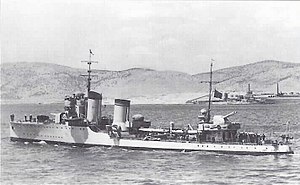Italian destroyer Francesco Crispi
 Francesco Crispi 1927
| |
| History | |
|---|---|
| Name | Francesco Crispi |
| Namesake | Francesco Crispi |
| Builder | Pattinson, Naples |
| Laid down | 21 February 1923 |
| Launched | 12 September 1925 |
| Completed | 29 April 1927 |
| Fate | Captured by the Germans, 9 September 1943 |
| Name | TA15 |
| Acquired | 9 September 1943 |
| Commissioned | 30 October 1943 |
| Fate |
|
| General characteristics (as built) | |
| Class and type | Sella-class destroyer |
| Displacement | |
| Length | 84.9 m (278 ft 7 in) |
| Beam | 8.6 m (28 ft 3 in) |
| Draught | 2.7 m (8 ft 10 in) |
| Installed power |
|
| Propulsion | 2 shafts; 2 geared steam turbines |
| Speed | 33 knots (61 km/h; 38 mph) |
| Range | 3,600 nmi (6,700 km; 4,100 mi) at 14 knots (26 km/h; 16 mph) |
| Complement | 152–153 |
| Armament |
|
Francesco Crispi was one of four Sella-class destroyers built for the Regia Marina (Royal Italian Navy) in the 1920s. Completed in 1927, she served in World War II.
Design and description
The Sella-class destroyers were enlarged and improved versions of the preceding
deep load. Their complement was 8–9 officers and 144 enlisted men.[2]
Unlike the
kW) for a speed of 33 knots (61 km/h; 38 mph) in service,[3] although the ship reached a speed of 38.6 knots (71.5 km/h; 44.4 mph) from 35,540 shp (26,500 kW) during her sea trials while lightly loaded.[4] The Sellas carried enough fuel oil to give them a range of 1,800 nautical miles (3,300 km; 2,100 mi) at a speed of 14 knots (26 km/h; 16 mph).[5]
Their
13.2-millimeter (0.52 in) machine guns. They were equipped with four 533-millimeter (21 in) torpedo tubes in two twin mounts amidships.[3] The Sellas could also carry 32 mines.[2]
Construction and career
Francesco Crispi was
laid down by Pattinson at their Naples shipyard on 21 February 1923, launched on 12 September 1925 and commissioned on 29 April 1927.[5]
Citations
Bibliography
- Brescia, Maurizio (2012). Mussolini's Navy: A Reference Guide to the Regina Marina 1930–45. Annapolis, Maryland: Naval Institute Press. ISBN 978-1-59114-544-8.
- Fraccaroli, Aldo (1968). Italian Warships of World War II. Shepperton, UK: Ian Allan. ISBN 0-7110-0002-6.
- Greene, Jack & Massignani, Alessandro (1998). The Naval War in the Mediterranean, 1940–1943. London: Chatam Publishing. ISBN 1-86176-057-4.
- McMurtrie, Francis E., ed. (1937). Jane's Fighting Ships 1937. London: Sampson Low. OCLC 927896922.
- O'Hara, Vincent P. (2009). Struggle for the Middle Sea: The Great Navies at War in the Mediterranean Theater, 1940–1945. Annapolis, Maryland: Naval Institute Press. ISBN 978-1-59114-648-3.
- Roberts, John (1980). "Italy". In Chesneau, Roger (ed.). Conway's All the World's Fighting Ships 1922–1946. New York: Mayflower Books. pp. 280–317. ISBN 0-8317-0303-2.
- ISBN 1-59114-119-2.
- ISBN 1-85409-521-8.
External links
- Francesco Crispi Marina Militare website
